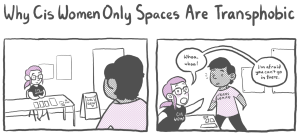
Source: Huffington Post
Author’s Note: This piece is in dedication to Sandra Bem, who passed away May 22, 2014.
Whether you’re a parent, an aspiring parent, or someone who never wants children, the way that you talk about gender to children is extremely important.
Although they do a majority of their learning through observation of their peers in social situations, children’s groundwork for understanding gender is largely influenced by the adults they see in their family systems.
So why is it important to talk to your kids about gender? Because if you don’t, they’ll learn society’s gender model: antiquated, polarized, and mutually exclusive labeling of gender and gender roles.
And that model is not exactly conducive to a world of true equality and inclusion, as it leads to oppression of a large group of people — anyone who identifies with or has feminine characteristics.
Yes. In the last few decades, we have made progress in seeing traditionally feminine characteristics more positively, but people with “effeminate” traits still face inequity and oppression every day.
If we are to live truly feminist lives, part of our practice must be to refrain from contributing to the oppression of others in any form. Becoming more informed and versed in the complexity of gender can help us begin to intentionally live in ways that do not perpetuate or reinforce gender stereotypes.
By modeling this understanding to our children, we can effect change for the next generation and interrupt long-standing oppressive structures.
But let’s back up for a second. How is it that so much of our children’s concept of gender is completely out of our control? The simple answer is gender socialization.
A branch of socialization, gender socialization is a process by which people “learn” about gender roles and expectations by observing cultural codes and witnessing what happens to those who do not follow them.
In school, kids see the social consequences of not following norms, and quickly learn that to be accepted is to conform. But while much of the social learning your child does occurs at school, what you do at home can go a long way toward increasing your child’s flexibility in thinking about gender and becoming a more inclusive-minded human being.
So here are five ways that you can start to celebrate and facilitate your child’s gender autonomy.
1. Encourage an Array of Options
Encourage your child to try all kinds of activities — not just the ones that reflect the gender they were assigned at birth. Doing so gives them permission to be active agents in the construction of their own gender expression.
While people are showering you with gifts that send your child the message that they must adhere to society’s understanding of their gender, show them that you want them to decide for themselves what they want to do, to wear, and to be.
You can also model this for your children by participating in a variety of different activities that are associated with various different gender identities.
By allowing your child to explore books, toys, games, movies, and people that do not perpetuate gendered ideals, you are fostering within them a sense of gender elasticity.
In demonstrating that gender is not a restrictive field, you are raising an understanding and accepting child who will be able to form stronger connections with others later in life.
2. Allow for Androgyny
Sandra Bem, a feminist psychologist and researcher, wrote extensively about androgyny, an expression of genders that does not encompass a single continuum, but allows for a more comprehensive understanding of how masculinity and femininity play into our overall gender expression.
Before Bem’s revolutionary work, gender (both in identity and expression) was commonly conceptualized as a spectrum from man to woman and sex from male to female.
Although it was beginning to be acknowledged that a person could fall in different places along this spectrum without using a binary understanding, the single spectrum still didn’t allow for expressions of gender that encompassed both “masculine” and “feminine” traits simultaneously.
Bem’s radical new view could allow for, instead of movement along one single spectrum, oscillation along two spectra that is fluid and allows for many more ways of understanding and expressing gender.
Beyond this, Bem also suggested that androgyny is actually healthier and is a feature of more psychologically well-adjusted individuals.
So, instead of giving your daughter praise only for performing “feminine” behaviors (i.e., nurturance, domestic tasks, etc.), use gender-neutral praise and encouragement to allow for a flexible interplay with gender within your child.
Try to model and encourage both traditionally feminine and masculine traits, as it can help your child have better long-term outcomes.
3. Watch Your Language
Each day that you send your child off to school on a big yellow school bus, sack lunch in hand, they enter a world where gendered language is commonplace.
Girls and boys are separated and treated differently solely because of others’ assumptions. Playground folly is littered with gendered put-downs and criticisms.
This is your opportunity to teach your child that their assumed or assigned genders do not define them and should have no bearing on how they express themselves and live authentically. Instead of giving praise such as, “Great job! You are such a smart girl,” try using encouragements that don’t acknowledge gender at all, thereby erasing the association between identity and expression: “Thank you for being such a hard worker.”
When we couple gender and accomplishments, we are reinforcing the idea that the child’s hard work is in some way tied to the fact that they express certain “gendered” traits.
Being open with children and helping them understand how humans are really just different intersectional combinations can help shift their understanding of gender expression from fixed to fluid.
Explore resources on gender identity and share them with your children, but also…
4. Remember: Gender Identity and Gender Expression Are Different
What we see and how we feel are very different, and the two are often at odds. Children are no different.
Just because a child is young doesn’t mean that we should deny them the right to explore expression as we do. (This would be ageism, which I despise and which you can read about here.)
The way they begin to identify and how they express it are entirely distinct phenomena; although they are related, they should be considered individually and with care.
If you were to account for all of the ways in which you express yourself, chances are that you would not reflect solely one gender. Rather, you have many tools to traverse the world that do not belong to any sex or gender alone.
Expression and identification (both internally and externally) play massive roles in children’s perception of their genders and what they understand to be acceptable.
Show them how diverse one individual can be in these facets and help them understand the difference between biological sex and gender identity and how wonderful it is to express Self, independent from either!
***
Gender expression is a construct that is affected by and reflective of how a person experiences the world and ways in which they see the self. Before judging or controlling, talk with your child about genders and the importance of being inclusive.
If your child gravitates toward varying activities and clothes, that’s a very positive thing. If they gravitate toward gendered things that “match” their biological sex, that’s great, too!
Whatever the case is, be accepting and understanding with your child and their gender. Spark change by opening the channels of thought surrounding gender in our next generation.
And whatever discoveries your child makes about gender, celebrate with them.
[do_widget id=”text-101″]
Want to discuss this further? Visit our online forum and start a post!
Lauren Rosenthal is a Contributing Writer for Everyday Feminism. She is a Gemini with aspirations of helping people (and herself) move toward authenticity. She enjoys reading and spending time with people and cats. Lauren’s main interests of activism are awareness surrounding sexual and gender diversity, women and body issues, and ageism as an invisible but pervasive form of oppression. Aimless musings and other thoughts of hers can be read on her personal blog, and she loves e-conversing with anyone interested in the history of feminism and what it means for women of all ages today. Read her articles here.
Search our 3000+ articles!
Read our articles about:
Our online racial justice training
Used by hundreds of universities, non-profits, and businesses.
Click to learn more




















